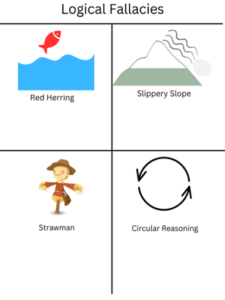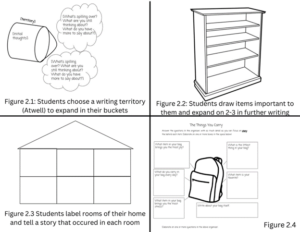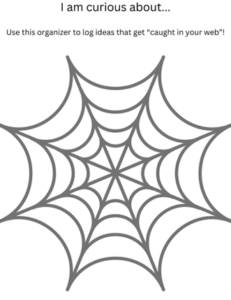This blog post was written by NCTE member Alison Goulding.
Visual metaphors are images or graphics that explicitly represent another object, but also function to name writing moves. In doing so, these metaphors can serve as a playful entryway into writing or discussion. While visual metaphor tools are akin to one-pagers, their format differs due to their abstractness.
Visual metaphors can be concrete—like a handout, or they can stay in the abstract and thematically connect ideas of the process you are describing. Utilizing metaphors is a way to ensure more students find the materials accessible to them. Visual metaphors may not be the entryway for all learners, but they will be for some. Adding visual metaphors to the secondary English classroom casts a wider net for student understanding.
Working with visual metaphors also invites students into critical, abstract thinking that segues into disciplinary work with metaphors. As students understand the visual metaphors you create in class, you have stepping stones to transfer this skill into reading and creating their own metaphors. This tool then becomes a model for creation!
Using Visual Metaphors
 Direct Instruction
Direct Instruction
Being able to create a logical metaphor on a given topic reveals how well one understands the concepts. As teachers, we are experts in our subject matter and are responsible for relaying knowledge in a clear way. Metaphors are one way we do this, and as English teachers, we do this especially often.
We may describe to students the writing process in terms of the parlor metaphor (Nordquist 2018), or teach early theme ideas as “theme seeds” that grow into larger “theme trees” (Reiman 2023) throughout the course of a text. Metaphors are abundant in our practice, and making these visuals provides new entry for students into the work.
Student Writing
The tool of visual metaphors has the most prominent usage in idea generating. Creating topics and ideas for larger summative assessments can feel daunting and scary, but visual metaphors add a playful element to the work. These can be used as set inductions or expanded into a larger lesson, depending on the needs of your students and classroom. I have a variety of visual metaphors I have created to aid students in generating ideas for a personal narrative piece.
While these tools were created to generate ideas for personal narrative writing, with minor adjustments they could move into generating ideas about a text. The figure to the right, for example, could be changed to focus on setting in a novel, and could delve into important objects and symbolism. These revisions would need further refinement to move from comprehension strategies to higher levels of thinking; however, the usage of visual metaphors does not need to be limited to idea generating for personal writing.
 Additionally, tools like an idea web could be maintained throughout the semester. By creating a return to a metaphor, students are required to reiterate this complex abstract thinking more often, leading to higher possibilities for transfer. The figure to the left could be used for any course or type of writing to encourage repeated thinking about topics of interest.
Additionally, tools like an idea web could be maintained throughout the semester. By creating a return to a metaphor, students are required to reiterate this complex abstract thinking more often, leading to higher possibilities for transfer. The figure to the left could be used for any course or type of writing to encourage repeated thinking about topics of interest.
Lastly, almost everything we say is a metaphor in some way (Lakoff and Johnson 1980). Even in this piece, I have used the metaphor “casting a net” to describe reaching a larger audience and “stepping stones” to depict scaffolding. Visualizing these abstract metaphors into concrete tools for writing invites students into a new kind of writing work that can transfer into meaning-making of textual metaphors.
Visual metaphors may not click for every student, and that is okay! Used intermittently with other types of writing and creating, this tool can include more types of thinking and writing to expand students’ critical thinking. These resources can be easily returned to and adjusted to fit different needs and skills to incorporate into almost any unit. This entryway for return and repeated work with an organizer allows students faster entry into meaning-making.
References
Atwell, Nancie. 2017. Lessons That Change Writers. Portsmouth, NH: Heinemann.
Lakoff, George, and Mark Johnson. 1980. Metaphors We Live By. Chicago: University of Chicago Press.
Nordquist, Richard. 2018. “What is the Burkean Parlor?” ThoughtCo. August 10, 2018. https://www.thoughtco.com/what-is-burkean-parlor-1689042.
Reiman, Amy. 2023. American Literature Course, University High School, Normal IL.
 Alison Goulding is a recent graduate of Illinois State University where she studied the enactment of socially just ELA instruction. She has begun MA courses through the University’s accelerated program. Goulding is beginning her first year of teaching this fall. She can be reached via email.
Alison Goulding is a recent graduate of Illinois State University where she studied the enactment of socially just ELA instruction. She has begun MA courses through the University’s accelerated program. Goulding is beginning her first year of teaching this fall. She can be reached via email.
It is the policy of NCTE in all publications, including the Literacy & NCTE blog, to provide a forum for the open discussion of ideas concerning the content and the teaching of English and the language arts. Publicity accorded to any particular point of view does not imply endorsement by the Executive Committee, the Board of Directors, the staff, or the membership at large, except in announcements of policy, where such endorsement is clearly specified.

